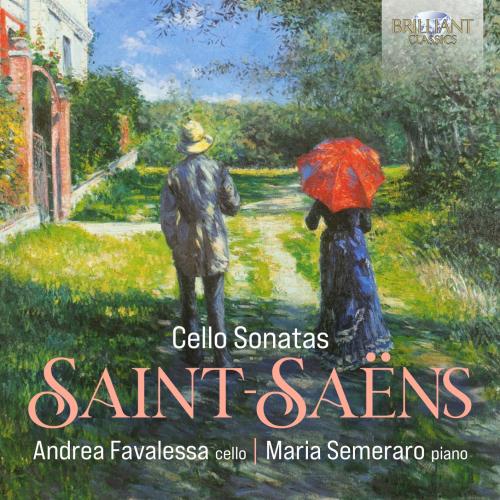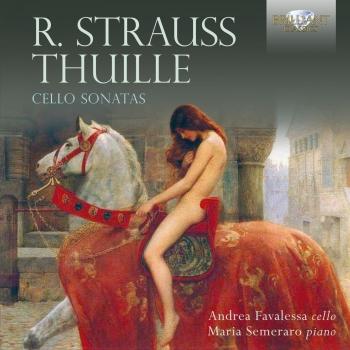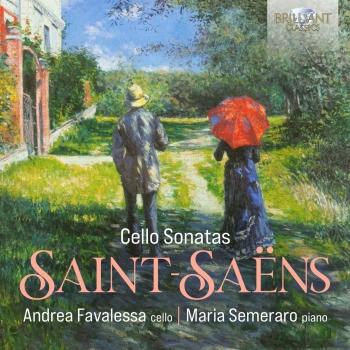
Saint-Saens: Cello Sonatas Andrea Favalessa & Maria Semeraro
Album info
Album-Release:
2022
HRA-Release:
26.08.2022
Label: Brilliant Classics
Genre: Classical
Subgenre: Chamber Music
Artist: Andrea Favalessa & Maria Semeraro
Composer: Camille Saint-Saens (1835-1921)
Album including Album cover
- Camille Saint-Saëns (1835 - 1921): Cello Sonata No. 1 in C Minor, Op. 32:
- 1 Saint-Saëns: Cello Sonata No. 1 in C Minor, Op. 32: I. Allegro 08:55
- 2 Saint-Saëns: Cello Sonata No. 1 in C Minor, Op. 32: II. Andante tranquillo Sostenuto 05:49
- 3 Saint-Saëns: Cello Sonata No. 1 in C Minor, Op. 32: III. Allegro Moderato 06:14
- Cello Sonata No. 2 in in F Major, Op. 123:
- 4 Saint-Saëns: Cello Sonata No. 2 in in F Major, Op. 123: I. Maestosto, Largamente 09:26
- 5 Saint-Saëns: Cello Sonata No. 2 in in F Major, Op. 123: II. Scherzo con variazioni. Allegro Animato 09:12
- 6 Saint-Saëns: Cello Sonata No. 2 in in F Major, Op. 123: III. Romanza. Poco Adagio 08:57
- 7 Saint-Saëns: Cello Sonata No. 2 in in F Major, Op. 123: IV. Allegro non troppo, Grazioso 06:42
Info for Saint-Saens: Cello Sonatas
Vor der Wende zum 20. Jahrhundert bereicherte Camille Saint-Saëns das Cellorepertoire mit zwei bedeutenden Kompositionen: dem Cellokonzert Nr. 1 in a-Moll (Op. 33) und der Cellosonate Nr. 1 in c-Moll (Op. 32), die er dem Cellisten Jules Lasserre widmete. Der Schriftsteller Emile Baumann bezeichnete diese erste Cellosonate als "ein einzigartiges Werk", ein Meisterwerk. Sie wurde im Herbst 1872 komponiert und am 26. März 1873 in der Salle Érard in Paris mit J. Reuschel am Cello und dem Komponisten am Klavier uraufgeführt. Das Werk ist in drei Sätze gegliedert: der erste und der dritte haben einen tragischen Charakter, während der zweite eine Oase der Ruhe und Gelassenheit bietet. Das Werk beginnt mit einem dramatischen Allegro in Sonatenform. Der zweite Satz geht auf eine Orgelimprovisation zurück, die Saint-Saëns in Saint-Augustin aufgeführt hat. Der letzte Satz nimmt den stürmischen und aufgewühlten Charakter des ersten Satzes auf und endet in einem unerbittlichen Wettlauf.
Etwa 30 Jahre liegen zwischen der Cellosonate Nr. 2 in F (op. 123) und ihrer Vorgängerin. Sie ist das Ergebnis mühevoller Arbeit und wurde Anfang 1905 vollendet. Saint-Saëns schrieb am 16. März 1905 an seinen Verleger Jacques Durand in typisch selbstironischem Ton - oder vielleicht auch nur, um die Erwartungen zu steuern: "Natürlich wird die zweite Sonate nicht an die erste heranreichen: als La Fontaine seine zweite Fabelsammlung veröffentlichte, erklärte jeder, sie sei der ersten unterlegen. Die Sonate ist in vier Sätze gegliedert, der erste in Sonatenform mit durchgehendem Kontrast zwischen heroischem und lyrischem Charakter. Der zweite Satz ist ein Scherzo mit acht Variationen, von denen jede ihre eigene Identität hat, aber dennoch eine Verbindung zum Thema aufweist, eine davon in Form einer Fuge. Der dritte Satz ist nach Saint-Saëns' Worten "eine Romanze, die Cellisten entzücken wird", und über den Schlussteil schrieb er, "das Adagio wird empfindsame Seelen zu Tränen rühren". Die Sonate endet mit einem spielerischen, leichten Rondo, in dem sich Klavier und Cello in technischer Virtuosität und imitatorischen Spielen üben.
Camille Saint-Saëns (1835-1921) ist einer der bedeutendsten französischen Komponisten des 19. Jahrhunderts, dessen Oeuvre neben einigen Opern und Kirchenmusik auch wichtige Orchester- und Kammermusikwerke sowie Werke für Soloinstrumente umfasst. Zu seiner Zeit machte sich Saint-Saëns aber auch als Pianist und Organist einen Namen. Seine Musik hat mit ihren mitreißenden Melodien, ihrer instrumentalen Brillanz und einer glücklichen Mischung aus Charme, Lyrik und Witz eine universelle Anziehungskraft.
Diese neue Einspielung präsentiert die beiden Cellosonaten von Saint-Saëns, die im Abstand von 30 Jahren entstanden sind. Beide verbinden Dramatik und Heiterkeit, sind Meisterwerke ihrer Gattung und Eckpfeiler des Repertoires. Gespielt von Andrea Favalessa (Cello) und Maria Semeraro in einer wunderbaren und sensiblen Partnerschaft, deren frühere Aufnahmen für Brilliant Classics (Strauss / Thuille Cellosonaten BC 95238 und Casella Complete Works for Cello & Piano BC 94823) in der internationalen Presse hervorragende Kritiken erhielten.
Aufgenommen im Dezember 2020 in Bernareggio, Italien.Das zweisprachige Booklet in Englisch und Italienisch enthält Linernotes der Pianistin sowie ein Profil des Duos.
Anrea Favalessa spielt ein Cello von Carlo Loveri (Neapel, 1884).
Andrea Favalessa, Cello
Maria Semeraro, Klavier
Andrea Favalessa
Active as a chamber musician and as a soloist, Andrea Favalessa, he graduated in 2001 with full marks and honors at the "G. Verdi "in Milan under the guidance of Maestro M. Bernardin, and in February 2006 he received the second-level academic diploma in the same Conservatory with honors and praise.
He has participated in various master classes with teachers such as: E. Dindo, M. Brunello, PN Masi, D. Geringas, R. Filippini.
He has won several awards as a soloist in national and international competitions, including first prize at the international competition "Rovere d'Oro" St. Bartholomew, the second prize at the International Competition "S. Omizzolo "of Padua; in November 2011 he was awarded the first prize at the International Cello Competition for Contemporary Music "V. Bucchi "in Rome and in June 2012 he won first prize at the International Competition" G. Zinetti "of Sangli.
In March 2002 he was awarded the bronze medal to the Merit of Culture and Art by the President of the Italian Republic.
He collaborates as a principal cellist with the Orchestra Regionale Toscana, the Orchestra of the Maggio Musicale Fiorentino, the 'Mozart Orchestra of Bologna, the Orchestra of the Teatro Carlo Felice in Genoa.
She collaborates with the Orchestra of the Teatro alla Scala, the Orchestra Filarmonica della Scala, the 'Orchestra Sinfonica Nazionale della RAI and the' Orchestra of Italian Switzerland.
From 2000 to 2003 he was a member of EUYO (European Union Youth Orchestra) and played with important directors in the main European concert halls.
A lifelong passion for chamber music has played with musicians such as Bruno Canino, F. Petracchi, K. Sahatci; Moreover, since 2004 collaborates with the pianist Maria Semeraro with whom he has won several prizes in national and international competitions such as the first prize in the European competition "Duchi D'Acquaviva" of Atri, the first prize and the special prize for the sonata Sandro Fuga in the national competition "S.Fuga" in Turin, the second prize at the international competition "Città di Pinerolo", the first prize at the international competition "Guido Papini" di Camaiore.
In March of 2014 he was released a CD dedicated to their music for cello and piano by Alfredo Casella for the label Brilliant Cassics.
He has performed in various halls and theaters including Venice (Teatro Malibran), Milan (Teatro dal Verme), Buenos Aires (Teatro Coliseu), Imola, Brescia (Auditorium San Barnaba), Bergamo (Piatti Sala), Gradara, Cervo (Piazza Corallini for the chamber music festival), Bologna (Accademia Filarmonica), Trento (Philharmonic Society), Rome (Discoteca di Stato), Padua (Auditorium C. Polini for the Friends of music), Verona (Hall Maffeiana Academy Philharmonic), Ravenna (Teatro Alighieri).
He made his debut as soloist with the Orchestra of the Assumption in Vigentino and later worked as a soloist with the Orchestra of the Musical Afternoons, the 'Philharmonic Orchestra of the Conservatory and the' Chamber Orchestra of Brescia.
In 2002 he recorded with pianist Simone Pioneers Sonata op.38 by Brahms for Stradivarius.
As a member of the ISCM (Italian Society of Contemporary Music) he has performed world premieres and recorded for the record company McHarmony, music for solo cello by E. Morricone, P. Arata, S. Bo, M. Di Gesu.
For the contemporary repertoire he has also collaborated with the Divertimento Ensemble and the 'MDI ensemble.
Andrea Favalessa plays a cello built by Carlo Loveri in 1884.
This album contains no booklet.














